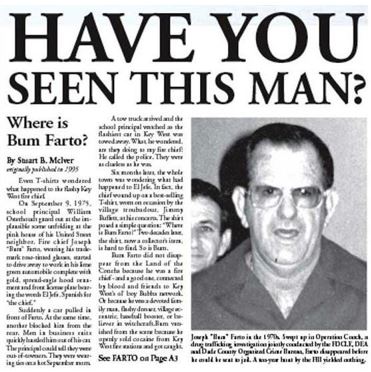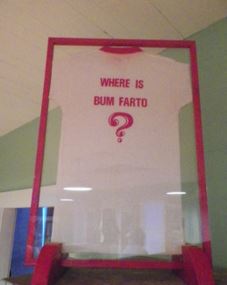¿Dónde está Bum Farto?
Life and Island Times August 2 2016 – ¿Dónde está Bum Farto?

Bum’s United Street house for sale in 2015
Key West has had its share of famous residents ranging from Ernest Hemingway to Tennessee Williams to Jimmy Buffett. But few have carved their name into Keys history in as infamous a manner as the drug-dealing local-born, Fire Chief in the 1970s, a man by the name of Joseph “Bum” Farto.
A year after Marlow arrived in the Keys in 1974 the local paper was splashed daily with headlines about the Fire Chief who was busted for selling drugs. What made his story a keeper for the ages is what followed in the next six months.
Marlow was reminded of this long ago tale, when a little piece of the Farto legend was listed for sale in November 2015 by a local realtor for $579,000. Soon after allegations of drug trafficking from his post at the fire station circulated the town, the Fire Chief with the distinctive name was snatched in front of his house while driving his lime green Caddy convertible which bore his signature license plate that read “El Jefe,” or “the chief” in Spanish.
The back story to Bum’s arrest was typical Key West. In the early 1970s, the free-and-easy lifestyle of the town became desperate and wide open. The US Navy, a powerful presence for more than a century, pulled out most of its forces in 1973, dealing a crippling blow to the island’s already fragile economy. Times were hard, and people turned, as they always had in the past, to illegal ways to earn a living. “Square grouper” – bales of marijuana – became the catch of the day.
Sometime in the early ’70s, Bum Farto succumbed to the lure of drug money. Selling marijuana from Colombia was so simple that he began peddling it while sitting on a bench outside the fire station. From marijuana he moved into cocaine.
Farto wasn’t the only entrepreneur serving a growing market. Bolita sellers moved through the streets, shouting “last call for the numbers;” bumper stickers declared, “When marijuana is legalized, I will be on welfare” and t-shirts read “Smoke Florida Seafood.” One detective was quoted as saying that cocaine in the 1970s was “as common as Key lime pie.”
On September 9, 1975, twenty eight agents posing as karate enthusiasts in town for a match, checked into the Key West Motel. Cruising around the city in unmarked cars dressed in suit and tie, they took down all of the known dealers in town by surprise, including Bum Farto.
In a wild outburst of legal incest, Farto and the other arrestees were all bailed out by a fellow defendant. They then all hired yet another fellow arrestee to defend them against charges of drug dealing that could send them to prison for more than thirty years apiece.
Farto’s trial was set for February. But on the morning of the trial he wound up instead in Key West De Poo Hospital. A few days later after being discharged from Depoo, Farto (yes, Marlow penned these words intentionally) faced the music.
The Key West jury took just thirty minutes to convict Farto on one count of selling marijuana and two counts of selling cocaine. The judge set sentencing for a day in early April.
Three days later, Bum Farto, free on bond, told his wife, Esther, he had to go to Miami to meet a friend. He took no luggage and said he would be back that day. No longer authorized to drive a fire department vehicle, he rented a Pontiac LeMans from Hargis Chevron on Truman Avenue and drove away.
Three weeks went by before Mrs. Farto called the Monroe County Sheriff Office on March 4. She had not seen her husband since the day he left to rent the car, she reported.
Police searched parking lots at Miami International Airport, but they found no trace of the car.
Meanwhile, Hargis Chevron filed a stolen-car complaint against Farto. The car, a company spokesman said, had been due back the day it was rented.

On March 22 – three weeks after Bum’s disappearance, Farto’s rental car was found parked on Calle Ocho in Miami’s Little Havana.
Only two days after his car was discovered t-shirts started to appear in Key West and consequently became very popular. Jimmy Buffett used to wear them at his concerts.

The T-shirt on display in the Key West Fire Station
Some thought the Mafia had connections to the disappearance. Regardless of whether the Mafia or drug cartels were involved in his disappearance, Bum’s body was never found. Other rumors abounded that the fugitive was alive and well in Costa Rica or Spain.
Ten years after he disappeared, Bum was declared dead. For probate purposes, that is. Though his estate was divided in 1986, Farto was not dead in the hearts of law enforcement officers, who still planned to prosecute him if he was ever found alive.
The estate money was important, Esther Farto said thrity years ago to the local paper. At 68, she had survived on a $231 monthly check from Social Security. She supplemented that by baby sitting and baking cakes and pastries in her United Street home.
There is a movie in this, no?
Copyright © 2016 From My Isle Seat
